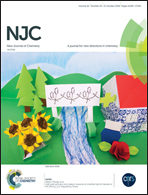High-yield synthesis and catalytic response of chainlike hybrid materials of the [(MoO3)m(2,2′-bipyridine)n] family†
Abstract
The one-dimensional organic–inorganic hybrid material [MoO3(2,2′-bipy)] (1) (2,2′-bipy = 2,2′-bipyridine) has been used as a starting material to prepare the bipy-deficient phases [Mo2O6(2,2′-bipy)] (2) and [Mo3O9(2,2′-bipy)2] (3) in excellent yields. The hybrid 2 was obtained by a solid-state thermal treatment of 1 (300 °C, 10 min) while 3 was obtained by a hydrothermal treatment of 1 (160 °C, 6 d). A study was performed to compare the catalytic properties of 1–3 in the epoxidation of cis-cyclooctene at 55 °C with tert-butylhydroperoxide (TBHP) or aqueous H2O2 as oxidant. In all cases Cy was converted to cyclooctene oxide (CyO) with 100% selectivity, and Cy conversions increased in the order 1 < 3 < 2, which parallels an increase in the Mo/2,2′-bipy molar ratio of the hybrid (1 < 1.5 < 2). With compound 2, CyO yields at 24 h were 96% for TBHP (cosolvent α,α,α-trifluorotoluene) and 53% for H2O2 (cosolvent CH3CN). The catalytic reactions occurred in homogeneous phase with active species formed in situ from 1–3. All three hybrids react with aqueous H2O2 to give the catalytically active oxodiperoxo complex [MoO(O2)2(2,2′-bipy)]. The 2 : 1 hybrid 2 was further examined for the epoxidation of other cyclic and linear non-functionalised olefins with TBHP, namely cyclododecene, 1-octene and trans-2-octene, and the biomass-derived olefins DL-limonene, α-pinene and methyl oleate.
![Graphical abstract: High-yield synthesis and catalytic response of chainlike hybrid materials of the [(MoO3)m(2,2′-bipyridine)n] family](/en/Image/Get?imageInfo.ImageType=GA&imageInfo.ImageIdentifier.ManuscriptID=C8NJ02668H&imageInfo.ImageIdentifier.Year=2018)


 Please wait while we load your content...
Please wait while we load your content...